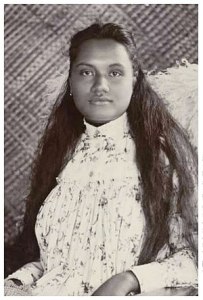
By Gabby Storey
Tui Manu’a Matelita, born Margaret Young on 31 December 1872 to Arthur Pa’u Young and Amipelia. Tui Manu’a is the title given to the ruler or paramount chief of the islands of Manu’a, now in American Samoa.
Matelita could claim descent from the Tui Manu’a line through her mother’s side. When the previous Tui Manu’a, Alalamua, died, an election by the faletolu, the council who decided upon the next ruler, took place.
Although she had an opponent from another descendant of the ruling line, Matelita was successfully elected and became paramount chief, and ascended to the rule of the islands on 1 July 1891. She was crowned on 13 July 1891.
Little is known of her brief reign, and it is likely that her role was entirely ceremonial. Matelita never married, and indeed her existence in the records is plausibly due to this fact, as she died with her virginial reputation intact.
The marriage of a female ruler posed a threat to the governance of the nation, seen in Europe as well as in Polynesia. Therefore, it may be that the Manu’ans discouraged Matelita from taking a partner to preserve internal sovereignty.
The most notable record of Matelita in Western European accounts is her meeting with Robert Louis Stevenson in 1894, who recorded Matelita’s lack of opportunity and activity as queen.

Matelita fell ill in September 1895 and died on 29 October 1895. A monument to her was built over her final resting place in what is now known as the Tui Manu’a Graves Monument.
Recommended Reading
Malama Meleisea, The Making of Modern Samoa: Traditional Authority and Colonial Administration in the History of Western Samoa (Suva: Institute of Pacific Studies, University of the South Pacific, 1987)
Malopa’upo Isaia, Coming of Age in American Anthropology: Margaret Mead and Paradise (Universal Publishers, 1999)
Niel Gunson, “Sacred Women Chiefs and Female ‘Headmen’ in Polynesian History,” The Journal of Pacific History 22.3 (1987): 139-172.
